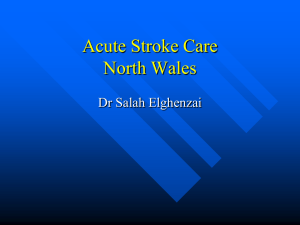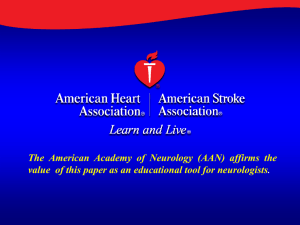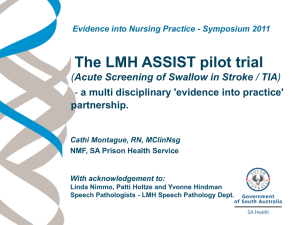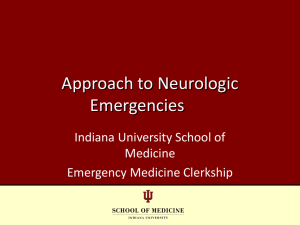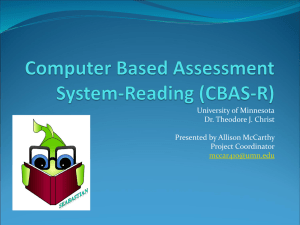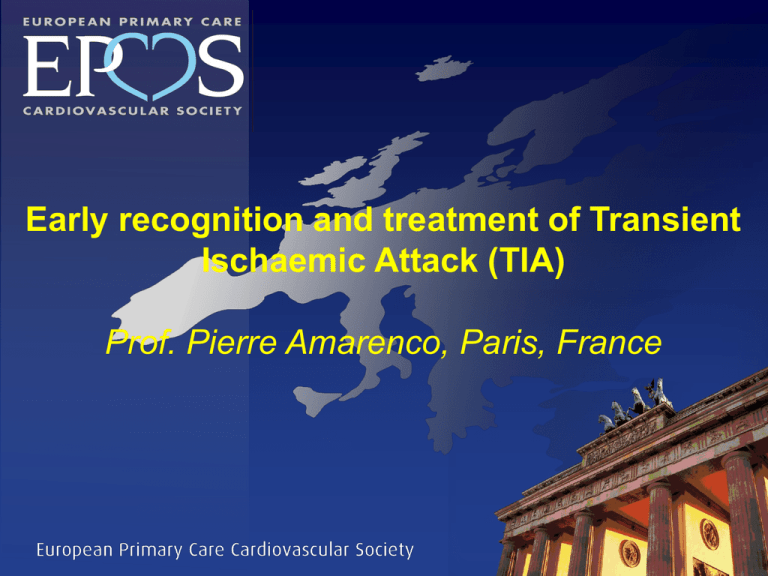
Early recognition and treatment of Transient
Ischaemic Attack (TIA)
Prof. Pierre Amarenco, Paris, France
What is a TIA….
• “Brief episode of neurologic dysfunction
caused by focal brain or retinal
ischemia, with clinical symptoms
typically lasting less than one-hour
• and without evidence of acute
infarction”.
Albers GW, Caplan LR, Easton JD et al. N Engl J Med 2002;347:1713-16
TIA : Symptom of stroke or
ministroke ?
Four Different Perspectives to define « TIAs »
•
In the community: Recognition of transient symptoms to detect patients at risk
for imminent stroke:
– Transient Neurologic Symptoms or
– Acute CerebroVascular Syndrome
•
Epidemiology study: differentiiation between transient and permanent symptoms
without necessary brain imaging available (duration might be useful)
•
Therapeutic trials: differentiation between TIA without brain lesion from those
with brain lesion (qualifying for brain infarction)
•
In the setting of a stroke unit: differentiation between transient symptoms from
persisting symptoms eligible for tPA, and later between transient symptoms with
brain lesion (infartion) and those without (e.g, different prognosis, risk
stratification perspective)
Four Different Perspectives to define « TIAs »
•
In the community: Recognition of transient symptoms to detect patients at risk
for imminent stroke:
– Transient Neurologic Symptoms or
– Acute CerebroVascular Syndrome
•
Epidemiologic study: differentiiation between transient and permanent
symptoms without necessary brain imaging available (duration might be useful)
•
Therapeutic trials: differentiation between TIA without brain lesion from those
with brain lesion (qualifying for brain infarction)
•
In the setting of a stroke unit: differentiation between transient symptoms from
persisting symptoms eligible for tPA, and later between transient symptoms with
brain lesion (infartion) and those without (e.g, different prognosis, risk
stratification perspective)
Four Different Perspectives to define « TIAs »
•
In the community: Recognition of transient symptoms to detect patients at risk
for imminent stroke:
– Transient Neurologic Symptoms or
– Acute CerebroVascular Syndrome
•
Epidemiology study: differentiiation between transient and permanent symptoms
without necessary brain imaging available (duration might be useful)
•
Therapeutic trials: differentiation between TIA without brain lesion from those
with brain lesion (qualifying the neurologic event as a brain infarction)
•
In the setting of a stroke unit: differentiation between transient symptoms from
persisting symptoms eligible for tPA, and later between transient symptoms with
brain lesion (infartion) and those without (e.g, different prognosis, risk
stratification perspective)
Four Different Perspectives to define « TIAs »
•
In the community: Recognition of transient symptoms to detect patients at risk
for imminent stroke:
– Transient Neurologic Symptoms or
– Acute CerebroVascular Syndrome
•
Epidemiology study: differentiiation between transient and permanent symptoms
without necessary brain imaging available (duration might be useful)
•
Therapeutic trials: differentiation between TIA without brain lesion from those
with brain lesion (qualifying for brain infarction)
•
In the setting of a stroke unit: differentiation between transient symptoms from
persisting symptoms eligible for tPA, and later between transient symptoms with
brain lesion (infartion) and those without (e.g, different prognosis, risk
stratification perspective)
Current view
• Use the term
– “Cerebrovascular syndrome” to qualify any
suspiscion of ischemic stroke (whether
transient or permanent, ischemic or
hemorrhagic)
• Keep the term
– “TIA” for symptoms without brain lesion on
neuro-imaging
Cumulative risk of
stroke after TIA
Cumulative risk of stroke
TIA vs minor stroke
25
OXVASC
14
20
Risk of stroke (%)
12
15
10
TIA
5
Minor stroke
10
OCSP
8
6
4
2
0
0
0
30
60
Days
BMJ 2004; 328: 326-8
90
0
7
14
21
Days
Lancet 2005; 366: 29-36
28
TIA: diagnosis needed
• 2,416 pts [OXVASC, OCSP, ECST, UK-TIA]
• 23% of strokes preceded by a TIA
– 17% same day
– 9% day before
– 43% within 7 days before index stroke
Rothwell P et al. Neurology 2005;64:817-820
Very Early Management in a
TIA Clinic :
80% stroke risk reduction at 3 months
EXPRESS
Next day visit
Rothwell et al. Lancet. 2007
SOS-TIA
Same day visit (24/24hr)
Lavallée et al. Lancet Neurol. 2007
SOS-TIA
• TIA clinic, 24/24 h, 7/7 d
• Objectives :
To make an urgent diagnosis of TIA
To find out the cause
in less than 4 hours
To prevent a stroke within the next
hours/days/weeks
Educational leaflet on
TIA
Mailed to:
15 000 PCP, cardiologists,
ophthalmologists, emergency
physicians, neurologists in Ile-deFrance (administrative region of
Paris)
Yesterday, I was watching TV, and suddendly the
Remote control fell down from my right hand. I could
not move my fingers during 3 minutes. And then, suddendly
I have totally recovered. Is it some fatigue, Doctor?
Do you know?
This is a TIA
This patient is at risk for a massive stroke within the
next hours?
Give
What to do?
300 mg
Don’t down grade the symptoms
of ASA
Tell the patient he is at risk for imminent stroke but
Prethat we can avoid it
hospital
Tell him we have to do immediate diagnostic testing
and treatment
TIA symptoms:
Carotid (anterior circulation)
• transient monocular blindness
• hemiplegie
• hemi sensory loss
• speech difficulties (aphasia)
Vertebrobasilar (posterior circulation):
• hemiplegie (may involved both sides, not at the same moment)
• unilateral paresthesia (same)
• total or partial visual field defect (one or both sides)
• ataxia with gait unstability
SUSPICION of TIA
SOS TIA
N°Vert
0 800 888 248
24/24 - 7/7
Nurse practitioner : Monday - Friday 9h to 17 h
Senior Vascular Neurologist on duty 17h to 9h and w.e.
TIA POSSIBLE
ADMISSION at the Day Clinic
Lavallée et al. Lancet Neurol. 2007
SOS-TIA
100% of patients had
their work-up done in <
4 hrs
75% of patients were
discharged home 3 or 4
hrs after admission to
the SOS-TIA clinic
2003-2005
SOS-TIA Model vs. Usual Care
LOS
1st Step
Recognition of TIAs - PCPs
GPs - Cardiologists - Ophthalmologists
100%
100%
TRIAGE
Admission
Stratifying
the risk
2nd Step According to a quick
work-up Vs.
to
TIA
Clinic
And underlying cause
Admission
To Stroke Unit
25%
3rd Step
75%
ABCD2 score
Admission
to Stroke Unit
Discharge
100%
< 1 day
vs.
6.5 days
European Stroke Organisation
2008 Recommendations
Cerebrovasc Dis. 2008;25(5):457-507. Epub 2008 May 6
NICE recommendations
July 2008
ABCD2 Score
Johnston C, Rothwell PM etal. Lancet 2006
Short-Term Risk of Stroke by ABCD2 Score
Johnston C, Rothwell PM etal. Lancet 2006
1622 -> 1176 Definite or possible TIAs
1622 -> 1176 Definite or possible TIAs
Does ABCD2 score less than 4 allow more
time to evaluate patients with TIA ?
Amarenco P, Labreuche J, Lavallée PC, et al. Stroke. 2009
SOS-TIA update 2003-2009
Predicting Short/Long-Term High-Risk of
Stroke/MI
CLINICAL
EVENTS
TIA
MARKERS OF RISK
Stroke/MI
Stenosis
DWI/MRI
Plaque
MODIFIABLE RISK
FACTORS
Intima-Media Thickness
A-Fib
Other CSE HTN/Diabetes/Cholesterol/Smoking…
Genes / Age / Gender / Hs-CRP / ACE / TM …
Triaging TIAs: MRI
Calvet D et al. Stroke. 2009;40:187-192
ABDC2 + I
OR for infarction on brain imaging
10
9
DWI- imaged cohorts
8
CT- imaged cohorts
7
6
5
4
3
2
1
0
≤1
2
3
4
5
6
7
ABCD2 score
Giles M, Rothwell PM, Amarenco P, et al. Stroke 2010
ABDC2 + I
Giles M, Rothwell PM, Amarenco P, et al. Stroke 2010
Causes of Brain Infarctions
Intracranial
Atherosclerosis
Carotid
Plaque with
Arteriogenic
Emboli
Penetrating
Artery
Disease
Flow
Reducing
Carotid
Stenosis
Aortic Arch
Plaque
Cardiogenic
Emboli
Atrial Fibrillation
Valve Disease
Left Ventricle Thrombi
SOS-TIA
Ultra-early Neurosonographic evaluation
in definite TIA
13% ECG abnormalities (10% AF)
Carotid US
Carotid athero
65%
Carotid stenosis ≥70%
8.6%
Intracranial stenosis
Or occlusion
13.9%
Aortic arch pl≥4 mm
Major CSE
PFO/ASA
14%
2%
19%
97.3% of 1881pts
DTC
97.3% of 1881 pts
TTE/TEE
96%/77% of pts
Lavallée PC, Labreuche J, Meseguer E et al. & Meseguer E, Lavallée PC, Mazighi M, et al. & Slaoui T, Lavallée PC, Labreuche J et al.
SOS-TIA: stratifying the risk
with TCD
Meseguer E, Lavallée PC, Mazighi M, et al. Ann Neurol. 2010
SOS-TIA
Stratifying the risk on the presence of
carotid plaque on carotid ultrasound
examination
N=1756
Carotid plaque
log-rank, p=0.001
Age and sex adjusted
RR=1.83 (95%CI, 0.84-4.01)
No carotid plaque
Risk of combined stroke, myocardial infarction and vascular death from time of presenting with
suspected TIA according to presence or absence of ICA atherosclerosis
1-yr rate of Stroke, MI, Vasc Death 3.7% vs. 1.3%
SOS-TIA: Immediate
Preventive Strategy for Mr B.
• Antiplatelet agent, pre-hospital
• Blood pressure lowering
• Statin therapy (after lipid profile determination in
fasting condition)
• Smoking cessation
• Anti diabetic treatment
• Oral anticoagulant (e.g., Atrial fibrillation)
• Carotid endarterectomy (stenosis ≥70%)
CONCLUSIONS
• TIA is an emergency: work-up has to be done < 24
hours, in a dedicated organized structure (TIA clinic)
• With fast evaluation = same day discharged for up to
75% of pts (Pt satisfaction/Cost-effectiveness)
• Risk becomes extremely low compared to that
expected with a RRR= 80% at 3 months
• TIA clinic should be developed in all comprehensive
stroke centres for same day evaluation
• It is no longer possible to wait more than 12 hours to
do the evaluation of a TIA
What should be the early
management of TIA patients
• Admission to a dedicated structure (no matter
the setting)
• Immediate evaluation and treatment
• A priori defined immediate process of care
–
–
–
–
Brain imaging
Arterial and cardiac evaluation
Blood testing
Full clinical evaluation
• Decision on orientation by a senior stroke
specialist: discharged home or admission to SU

